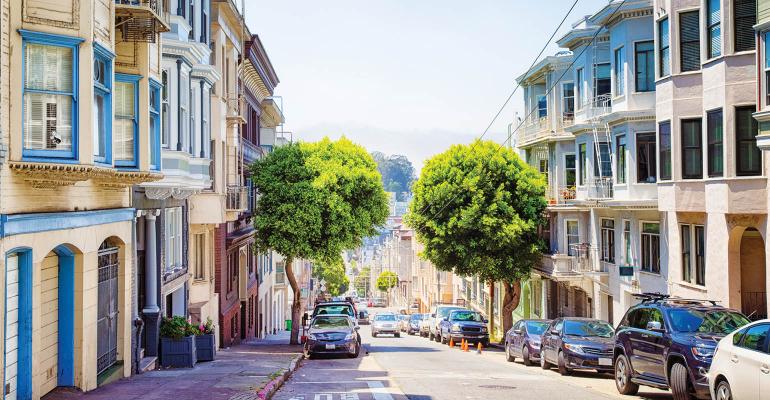Buyers are paying a little less for apartment properties in San Francisco than they used to.
“We’ve seen it on all levels, people are sharpening their pencils a little more,” says Ramon Kochavi, first vice president and regional manager in the San Francisco office of brokerage firm Marcus & Millichap.
The City on the Bay is still the most expensive market for apartment properties in the United States. But even here, rising interest rates are putting pressure on potential buyers. Also, several top buyers are expected to buy fewer apartment buildings this year as they digest the properties they purchased over the previous 12 months. Other investors are offering to sell their properties to avoid regulatory burdens like seismic retrofit requirements or the growing menace of rent regulation.
Cap rates inch higher
“Demand for apartment properties is still strong.” But “it might take four weeks to coalesce a bunch of offers rather than two weeks,” says Kochavi. “There are typically three qualified buyers for a typical property.”
Investors are accepting cap rates that average around 3.5 percent for buildings in class-A locations—for example, a 1920s rent-controlled building in a prime neighborhood like Pacific Heights. That’s up from cap rates that were close to 3.0 percent a year ago, according to Kochavi. There are few newer buildings available for sale in the city. Cap rates average 4.0 percent for apartment properties in class-B locations and 5.0 percent for class-C locations.
“Sales are closing at an average cap rate of just 3.6 percent, which ranks lowest among all U.S. markets,” says Jesse Gundersheim, market economist for research firm the CoStar Group.
The yield on investments on these properties has stayed low even as interest rates have risen, including the benchmark yield on 10-year Treasury bonds, which was higher than 3.0 percent for most of October, up more than 150 basis points from its most recent low point in the spring of 2016. That can’t last forever, especially as federal officials plan yet another increase to their own benchmark interest rate targets before the end of 2018.
Top buyers, including Veritas Investment Group and Dallas Investments, are also buying fewer apartment buildings this year as they assimilate properties they bought recently into their portfolios.
“The three major Bay Area markets—San Francisco, East Bay and San Jose—each experienced a peak in total sales volume in 2016 in conjunction with many primary U.S. coastal markets,” notes Gundersheim.
The volume of trading top apartment properties—those rated with four or five stars by CoStar—fell by more than 40 percent in San Francisco in 2017 compared to 2016. The sales volume on such building also likely dropped significantly in 2018.
At the same time, investors are still buying and selling large numbers of smaller properties, rated with just one or two stars by CoStar, which are often targeted for value-add upgrades. “Despite 2017’s significant decline in total investment volume, deal count actually rose to an all-time high last year, as smaller sales were prevalent,” says Gundersheim.
Rent control frightens some owners into selling
Some owners have also offered to sell properties because of the threat of new regulations, such as the potential rent control regulations that could be unleashed by California’s “Proposition 10” ballot initiative.
“Prop 10 has scared a lot of people over the past few months,” says Clinton Textor, a director in the national multi-housing group in the San Francisco office of Marcus & Millichap. “Our inventory of properties available for sale has spiked considerably… it has doubled.”
In November, voters will decide whether to allow local governments, including that of the City of San Francisco, to expand their rent control laws.
Proposition 10 would repeal Costa Hawkins, the state law that prevents rent control laws from applying to vacant apartments, apartments built after 1979, condominiums and single-family houses. If it passes, towns and cities around the state are expected to immediately begin the struggle over how much to expand their rent control laws. The latest polling shows sentiment tilting away from the proposal.
“We don’t think Prop 10 will pass… I don’t think people will exhale until it fails,” says Kochavi. The battle over rent regulation and the affordability of housing in the city won’t stop in November, however. “There is a constant barrage of new regulation.”
Seismic retrofit rules
Some owners of woodframe apartment buildings are selling to avoid another regulatory burden. San Fancisco’s “seismic retrofit” ordinance, passed in 2013, requires owners to add extra supports to help woodframe buildings survive an earthquake. The retrofits cost as much as $20,000 and need to be done by September 2019.
“There was a lot of procrastination—a lot of people waited till the last minute,” says Textor.
Despite these uncertainties, the demand for new apartments is expected to remain strong for the foreseeable future.
“We have way more jobs than we are producing units,” Textor adds. “There are natural barriers to building here.”
Developers have delivered more than 2,000 new apartment units in the market annually since 2013, with over 4,000 units expected to open in 2019—the most in a single year since the 1960s, according to CoStar. These units are expected to rent quickly. “Vacancy has declined towards expansion-era lows as new inventory is absorbed at a rapid pace,” says Gundersheim.
“We don’t overbuild in San Francisco,” adds Ramon.





